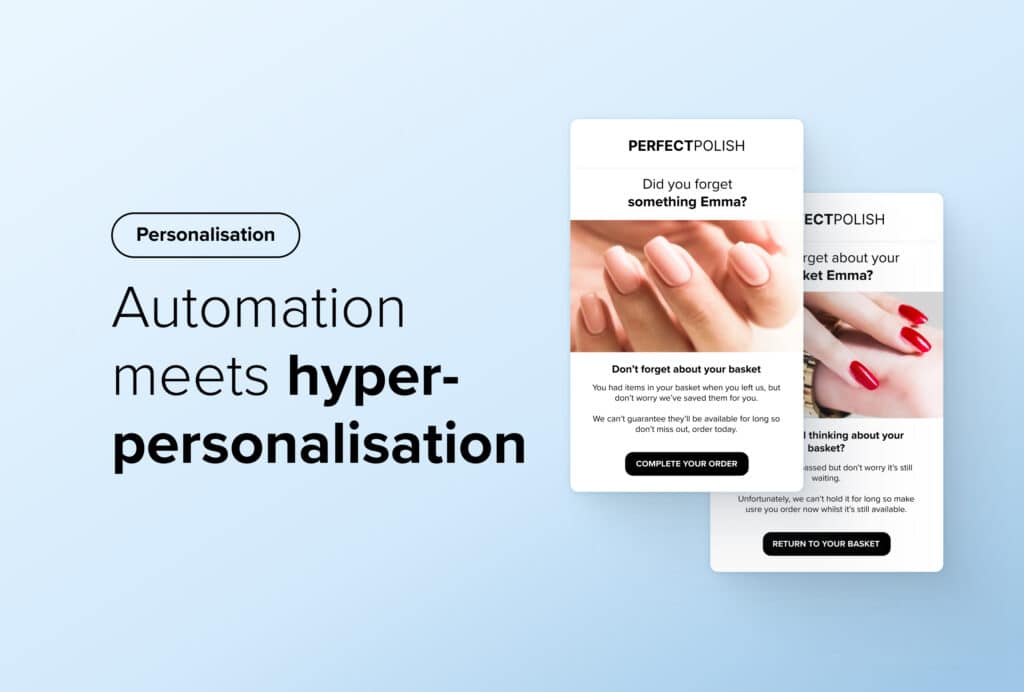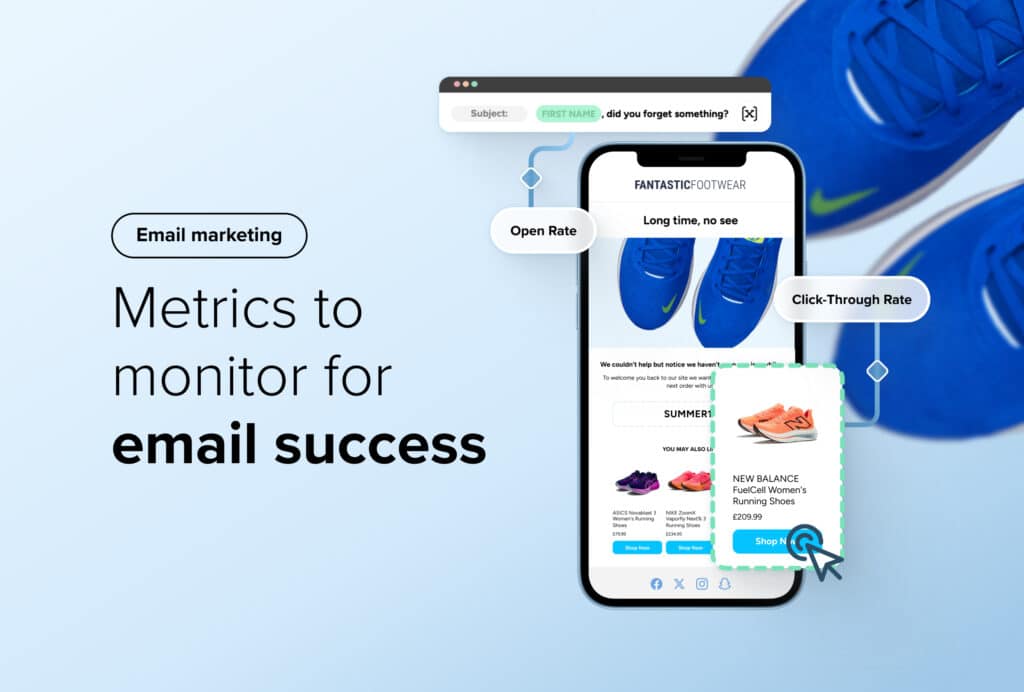How Will eCommerce Marketing Automation Fare in the Age of Hyper-Personalisation?
By Sophie Walker • Last updated: Thursday Jul 18th, 2024

In recent years we’ve seen huge growth within eCommerce and it’s predicted that 20.8% of retail purchases are expected to take place online in 2023.1
With web-savvy audiences favouring personalised online shopping experiences, this results in the need for more digital marketing communications as online transactions increase.
In this article, we’re going to discuss if there’s a place for marketing automation in the age of hyper-personalisation and how it may need to adapt to meet the needs of the modern consumer.
Marketing automation in the age of eCommerce
As the day-to-day workload of eCommerce retailers and marketers increased to meet customer demands, retailers sought out ways they could lighten their workload without compromising the user experience they want to provide.
The answer to this was found within marketing automation.
Retailers could now automate repetitive marketing tasks such as reactionary email workflows that respond to customer transactions and behaviour.
This also allowed them to trigger on-site messaging and campaigns at exactly the right time in the individual user journey.
In recent years this has been made easier than ever with the help of advanced tools and the latest technologies, allowing retailers to automate marketing tasks and transform their strategies for increased efficiency.
With automation, the capabilities of day-to-day eCommerce operations were taken to new heights, allowing retailers to increase conversions without sacrificing the user experience.
But the role of marketing automation has been thrown into question in light of the increased demand for hyper-personalisation.
Can automated marketing keep up with changing customer behaviour that’s now seeking fully tailored experiences?
Suggested reading: Read our article to find out ‘6 Ways to Use Automation to Create an Intelligent Customer Experience’
What is hyper-personalisation?
Before we dive into how marketing automation’s place in the hyper-personalised realm of eCommerce, let’s first clarify what’s meant by ‘hyper-personalisation’.
We all know how important it is to personalise experiences in eCommerce, with 71% of consumers feeling frustrated when a shopping experience isn’t personalised towards them.2
Traditional personalisation tactics that we all see regularly online are based on general customer preferences and past behaviour, this could include:
- Featuring a shopper’s name in communications
- Tailoring content based on past user demographic data
- Adjusting content to allow for a customer’s location
- Customising product suggestions based on purchase history
But hyper-personalisation goes beyond the traditional experience to take into account real-time customer behaviour and on-site responses.
Using insights from AI and big data, hyper-personalisation enables retailers to provide truly relevant product recommendations and promotions that are unique to each user journey.
How does marketing automation need to adapt in the age of hyper-personalisation?
Although automation was a big topic in the industry a few years ago it could now be seen as a tired subject, as marketers address the demand for hyper-personalisation online.
In theory, hyper-personalisation and marketing automation could be seen as two conflicting forces.
In reality, they are capable of working together seamlessly to provide exceptional customer experiences while also boosting ROI.
But to fare in the age of hyper-personalisation, marketing automation needs to adapt, here’s how.
Harness artificial intelligence
Automation driven by artificial intelligence, intelligent on-site optimisation, and reactionary email responses can form part of a wider, holistic approach to both on and off-site marketing.
Retailers can tap into AI to gain deeper insights into consumer behaviour and automate more personalised on-site communication.
When it comes to on-site marketing, it’s crucial to address how you can create unique customer experiences that make it effortless for your shopper to find their perfect purchase.
Artificial Intelligence analyses customer journeys, purchase histories and on-site behaviour to display Recommendations tailored to individual users.
There are a number of benefits of offering AI-driven Recommendations on-site such as:
- Increasing AOV: Recommendations create an opportunity to upsell and cross-sell genuinely relevant products to a user and encourage them to build bigger baskets.
- Quicker conversions: Speed up the steps to a conversion by offering handpicked products perfect for your shopper, making the browsing experience effortless.
- Hyper-personalised product suggestions: Make your shopper feel understood by your brand with hyper-personalised product suggestions and anticipate their own personal tastes and preferences, helping to strengthen the relationship with your brand.
AI can analyse vast amounts of customer data to help you to market your most relevant products directly to shoppers.
Transforming your on-site strategy and speeding up conversions, Recommendations is a marketing automation tool designed for maximum efficiency.
Optimise the whole customer journey
It’s safe to say automation has transformed the way retailers approach their digital marketing strategy.
With the help of the newest technology, retailers can now use automation to optimise the entire journey and transform optimal touchpoints.
However, automation shouldn’t just focus on one part of the user experience, it can be used to create an overall cohesive customer journey.
Retailers can enhance customer experience by utilising various forms of automation.
- Automated Overlays: Ensure on-site messaging is streamlined and surfaces at the most relevant points in the customer journey. Overlays use behavioural technology to pinpoint when a shopper needs that final push to complete their purchase.
- Follow-up Emails: Sending transactional emails, such as cart abandonment reminders or personalised product-focused drag-and-drop emails, you can use automation to re-inject users back into their shopping journey with reactionary email campaigns and workflows.
It’s now possible to automate multiple different touchpoints for a better overall customer journey and take action to increase customer satisfaction and brand loyalty in the long term.
Inform wider marketing strategies
There isn’t much point in integrating automation if it doesn’t work within your wider brand strategy.
With the advancement of technology and the increasing use of automation, busy marketers and retailers are finding it to be a useful solution, but it’s still essential to address how it could work for you and the long-term benefits it can bring to your eCommerce store.
Marketing automation strategies should complement your wider marketing strategies and support your tactics elsewhere on and off your site. It’s crucial to have a clear strategy behind your automations to make sure your marketing and on-site experiences are personal.
Looking to automation to achieve smarter, hyper-personalised communications in the form of Recommendations, tailored messaging, and campaigns, you can delight customers with a great site experience.
Advanced automation solutions are now available for retailers of all sizes to upgrade their day-to-day operations and catapult the efficiency of their brand strategy.
Be adaptive with your automation
While there’s no denying, automation can achieve the results modern retailers want to provide to their users, true hyper-personalisation takes time and isn’t going to happen all at once.
Your system should be adaptive in order to make the most of your efforts. AI solutions are a great way to achieve this as they allow you to be flexible with your responses and utilise customer data to explore the best approach.
When used in the right way, automation allows you to keep up with key industry trends and meet the ever-changing demands of modern shoppers.
Automation for hyper-personalised customer experiences
It’s crucial to remain agile with your automation solutions and monitor analytics to understand what is working for your eCommerce business.
If you implement marketing automation solutions that align with your brand strategy, you can effortlessly enhance customer satisfaction and improve conversion rates.
By personalising with the help of AI technology, automating reactionary emails, and optimising the on-site journey, you can take your marketing efforts to the next level with automation.
See how Salesfire can help you optimise your product discovery experience, email one of our experts at enquiries@salesfire.com or book a free demo of our personalisation tools.



